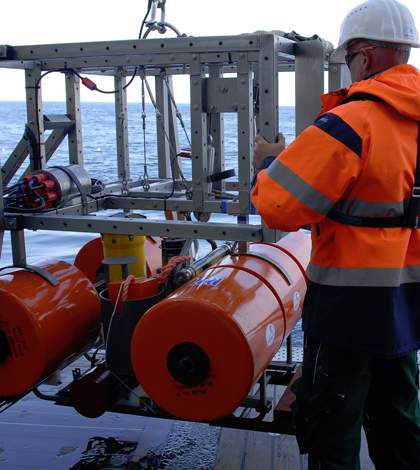Ocean Methane Seeps Tracked With Acoustic Recorders

A benthic lander with a High Frequency Acoustic Recording Package used to record methane seeps. (Credit: Peter Linke and Jürgen Schauer / GEOMAR Helmholtz Centre for Ocean Research)
The large-scale methane leak that plagued the city of Los Angeles from late 2015 through February 2016 was an environmental disaster that stemmed from a broken underground pipeline at a natural gas storage facility. The rupture prompted thousands to evacuate their homes and the governor of California to issue a state of emergency in January 2016.
But many of the large methane leaks that occur worldwide happen without any public outcry, regardless of the effects that they may have on the climate. This is because they take place underwater, somewhere far out in the ocean without an audience. The seafloor areas where these leaks take place are known as marine seeps and are clearly much more difficult to monitor than methane leaks on land.
Researchers at Scripps Institution of Oceanography are exploring the use of acoustic recording technology to better understand and monitor the sounds that these seeps produce as a way to track methane emissions. They describe the sounds of gas escaping from the vents like rain on a tin roof, accounting how the gas moves from the vents in the seabed and pinches off into bubbles.
The tones and sound levels of these emissions are related to bubble size, bubble plume density, and distance to the bubble plumes, researchers say. And all those measures provide important information about temporal variations of underwater methane release.
The Scripps researchers, in collaboration with others at the University of California, Santa Barbara, and the GEOMAR Helmholtz Centre for Ocean Research in Germany have used long-term, passive acoustic monitoring to continuously record methane seeps sounds over a seven-month period within the blowout crater at an abandoned well site in the central North Sea.
The crater, initially measuring 60 meters (197 feet) wide and 20 meters (66 feet) deep in a water depth of 100 meters (328 feet), was formed by a shallow gas blowout explosion from an oil exploration drill site in 1990 and has been spewing methane ever since. A 2011 survey estimated that approximately 90 liters (3 cubic feet) of gas was escaping from the seabed every second at the crater site.
The researchers collected two acoustic data sets in 2011 and 2012 from the crater site through the use of a High Frequency Acoustic Recording Package (HARP) data logger and a hydrophone (underwater microphone) attached to a benthic lander, an observational platform equipped with a multitude of sensors that sits on the seafloor to record physical, chemical, and biological activity.
The use of a HARP recording package to monitor methane seeps is novel, and the study is the first to showcase how the technique can be used to help scientists better understand the dynamic nature of marine seep systems. HARP technology was developed by scientists at the Scripps Whale Acoustics Lab to passively monitor sounds from marine mammals such as whales, dolphins, and seals, but it can also be used to study other sounds in the ocean such as those from ships, petroleum exploration and earthquakes.
Methane bubbles coming out of marine seeps have unique sound characteristics that allow them to be distinguished from other sound sources in the ocean. In this study, scientists knew there were marine seeps with methane emissions in the blowout crater and they determined that putting the HARP in the crater was the best way to record the seep sounds. They also noted that methane emissions are not always stable and can change by large amounts at times.
Over the course of the study, the scientists recorded a large eruptive event in December 2011, the first such observation of its kind. When the instruments were retrieved in 2012, the team observed a new gash in a nearby crater wall, from which an intense bubble plume had escaped. This major eruption also resulted in a new rift in the seafloor, causing the benthic lander to fall 6 meters deeper into the crater, and a persistent increase in sound levels was recorded thereafter.
The researchers also found the crater site’s sound levels to be positively correlated with ocean tides, meaning that when tides were high, the sound levels of the flowing methane bubbles were higher due to an increase in the overriding water pressure. This could be due to tidal flows or other processes that are poorly understood.
Researchers say that the study’s results show that passive acoustic monitoring is a viable technique for long-term monitoring of methane emissions from the seafloor, including daily trends associated with pressure changes due to tides and events like eruptions.
Next steps for the researchers is to look at the relationship between sound levels they measured and the amount of methane escaping the seafloor. If they can pinpoint such a relationship, that would allow for better methane emission estimates at seafloor sites. Climate change researchers could also use the estimates, along with models of how methane is transported through the water column to the atmosphere, to develop more accurate models of greenhouse gas inputs.
Full results of the work are published in the journal Marine and Petroleum Geology.
Top image: A benthic lander with a High Frequency Acoustic Recording Package used to record methane seeps. (Credit: Peter Linke and Jürgen Schauer / GEOMAR Helmholtz Centre for Ocean Research)




0 comments